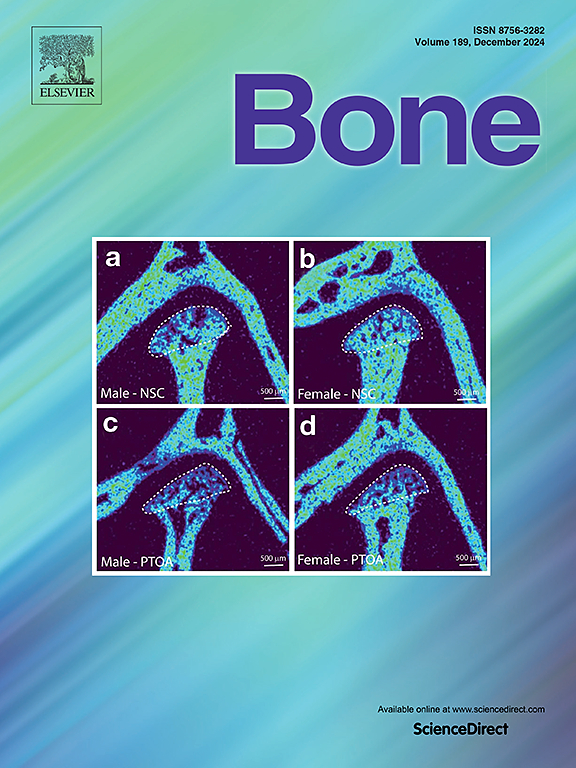小鼠对Yoda1和全身振动的骨骼反应随动物年龄、骨间隔、治疗时间和辐射暴露而变化。
IF 3.5
2区 医学
Q2 ENDOCRINOLOGY & METABOLISM
引用次数: 0
摘要
在这项研究中,我们研究了Yoda1(一种机械敏感的Piezo1通道激动剂)和全身振动(WBV)对辐射暴露后幼龄小鼠(8周龄)和成年小鼠(31- 36周龄)的骨骼影响,单独和联合使用。我们的目标是确定这两种以机械生物学为基础的干预措施(已知在年轻受试者中单独诱导合成代谢反应)是否可以促进接受癌症治疗(如放疗)的老年受试者的骨骼健康。我们的假设是,与单独使用Yoda1或WBV相比,Yoda1和WBV联合使用可以更好地改善放疗后的年轻骨骼和保护成熟骨骼。我们的体内实验证明(1)Yoda1(5 mg/kg体重)单独或联合WBV(0.3 g, 13 Hz, 30 min/天,5 天/周,4 周)类似地促进了年轻小鼠的骨生长(相对于未处理的对照组约2倍);(2)成熟小鼠对单独干预无反应,但在接受Yoda1和WBV联合治疗(15 min/day)的小鼠胫骨中表现出较少的极性惯性矩损失(-56 %),但没有辐射暴露;(3)对侧胫骨接受分次放疗(2 × 8 Gy, 3天)在第4周没有表现出不同的治疗反应,而在第2周对联合治疗有反应(皮质骨形成增加)。有趣的是,对同一动物的辐照和未辐照胫骨的配对比较显示,无论治疗方式如何,辐照暴露导致小梁骨丢失减少,并且在接受Yoda1或联合治疗的组中,维持更好的皮质极性惯性矩和皮质面积的胫骨百分比增加。对Yoda1和/或WBV的复杂骨骼反应是室特异性的(皮质骨或小梁骨),并依赖于动物年龄、辐射暴露和治疗时间。本研究部分支持了我们最初的假设,同时提出需要微调Yoda1和WBV方案,并阐明潜在的机制,以有效治疗年龄和辐射引起的骨质流失。本文章由计算机程序翻译,如有差异,请以英文原文为准。

Skeletal response to Yoda1 and whole-body vibration in mice varied with animal age, bone compartment, treatment duration, and radiation exposure
In this study, we investigated the skeletal effects of Yoda1, an agonist of the mechanosensitive Piezo1 channels, and whole-body vibration (WBV), alone and combined, in young mice (8-week-old) and in mature (31- to 36-week-old) mice after radiation exposure. Our goal was to determine whether the two mechanobiology-based interventions, known to induce anabolic response individually in young subjects, could promote bone health of older subjects undergoing cancer treatments such as radiotherapy. Our hypothesis was that the combination of Yoda1 and WBV could improve young skeletons and protect mature skeletons after radiotherapy better than Yoda1 or WBV alone. Our in vivo experiments demonstrated (1) that Yoda1 (5 mg/kg body weight) alone or combined with WBV (0.3 g, 13 Hz, 30 min/day, 5 days/week, 4 weeks) enhanced bone growth similarly (∼2 folds relative to nontreated controls) in young mice; (2) that mature mice were unresponsive to individual interventions but exhibited less polar moment of inertia loss (−56 %) in the tibiae receiving the combination of Yoda1 and WBV (15 min/day) but no radiation exposure; and (3) that the contralateral tibiae receiving fractionated radiation (2 × 8 Gy over three days) did not show different treatment responses in Week 4, while they responded to the combination therapy (increased cortical bone formation) in Week 2. Interestingly, pair comparisons of the irradiated and non-irradiated tibiae of the same animals revealed that radiation exposure resulted in decreased trabecular bone loss regardless of the treatments and increased the percentage of tibiae maintaining better cortical polar moment of inertia and cortical area in the groups receiving Yoda1 or the combination therapy. The complex skeletal responses to Yoda1 and/or WBV were compartment specific (cortical or trabecular bone) and dependent on animal age, radiation exposure, and treatment duration. This study partially supported our original hypothesis, while suggesting the need of finetuning the Yoda1 and WBV regimens and elucidating the underlying mechanisms in order to effectively treat age and radiation induced bone loss.
求助全文
通过发布文献求助,成功后即可免费获取论文全文。
去求助
来源期刊

Bone
医学-内分泌学与代谢
CiteScore
8.90
自引率
4.90%
发文量
264
审稿时长
30 days
期刊介绍:
BONE is an interdisciplinary forum for the rapid publication of original articles and reviews on basic, translational, and clinical aspects of bone and mineral metabolism. The Journal also encourages submissions related to interactions of bone with other organ systems, including cartilage, endocrine, muscle, fat, neural, vascular, gastrointestinal, hematopoietic, and immune systems. Particular attention is placed on the application of experimental studies to clinical practice.
 求助内容:
求助内容: 应助结果提醒方式:
应助结果提醒方式:


